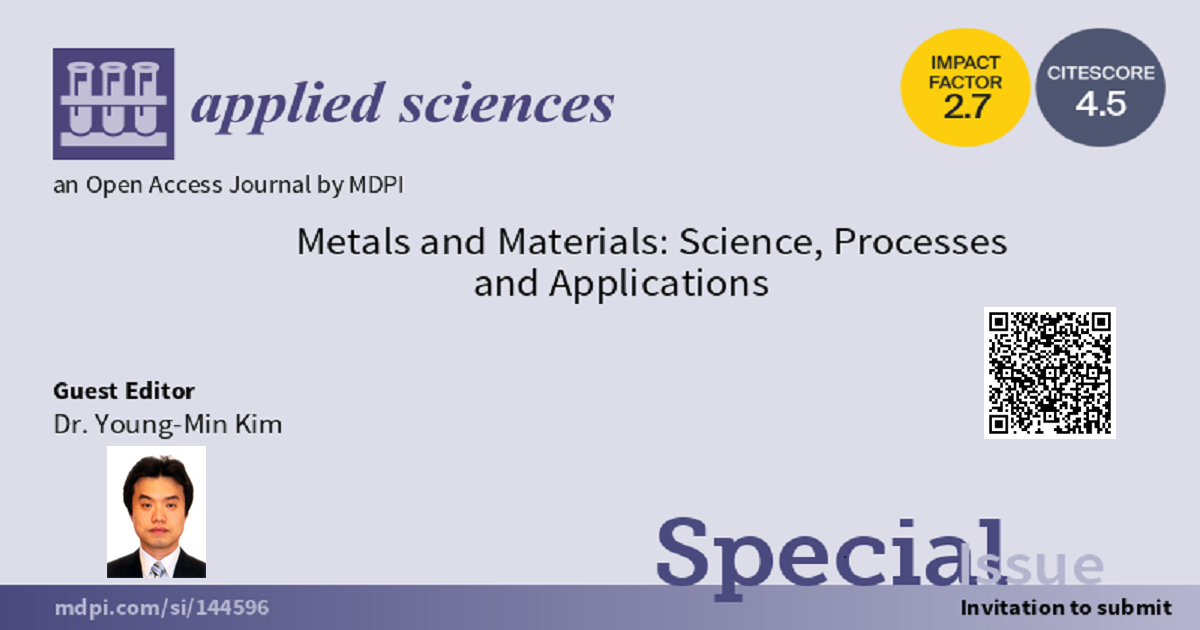Metals and Materials: Science, Processes and Applications
A special issue of Applied Sciences (ISSN 2076-3417). This special issue belongs to the section "Materials Science and Engineering".
Deadline for manuscript submissions: closed (31 May 2024) | Viewed by 29636

Special Issue Editor
Interests: alloy design; thermodynamic modeling; welding metallurgy; cladding; high-entropy alloy; resistance spot welding
Special Issues, Collections and Topics in MDPI journals
Special Issue Information
Dear Colleagues,
Various materials, including metal, exist in our daily life. Each metal and material is applied in various fields in accordance with its unique characteristics. To understand the mechanical, physical, and chemical properties of metals and materials, it is necessary to understand scientific principles. Through this understanding, the design for processes and applications of related materials can be achieved.
This Special Issue covers all aspects of the sciences, processes, and applications related to the properties of various metals and materials. We welcome all research fields, from theoretical approaches to experiments associated with metals and materials. This Special Issue also covers materials’ characterization, physical properties, and mechanical behavior; modern alloy developments; ceramics and glasses; plastics and composites; and corrosion and surface engineering. In addition, this issue includes but is not limited to process design and manufacturing processes involving metals and materials. Computational science involving materials is also a topic of interest.
Dr. Young-Min Kim
Guest Editor
Manuscript Submission Information
Manuscripts should be submitted online at www.mdpi.com by registering and logging in to this website. Once you are registered, click here to go to the submission form. Manuscripts can be submitted until the deadline. All submissions that pass pre-check are peer-reviewed. Accepted papers will be published continuously in the journal (as soon as accepted) and will be listed together on the special issue website. Research articles, review articles as well as short communications are invited. For planned papers, a title and short abstract (about 250 words) can be sent to the Editorial Office for assessment.
Submitted manuscripts should not have been published previously, nor be under consideration for publication elsewhere (except conference proceedings papers). All manuscripts are thoroughly refereed through a single-blind peer-review process. A guide for authors and other relevant information for submission of manuscripts is available on the Instructions for Authors page. Applied Sciences is an international peer-reviewed open access semimonthly journal published by MDPI.
Please visit the Instructions for Authors page before submitting a manuscript. The Article Processing Charge (APC) for publication in this open access journal is 2400 CHF (Swiss Francs). Submitted papers should be well formatted and use good English. Authors may use MDPI's English editing service prior to publication or during author revisions.
Keywords
- metallic materials
- non-metallic materials
- manufacturing process
- material characterization
- mechanical properties
- microstructure
- alloy design
- simulation
- advanced applications
- processing techniques
Benefits of Publishing in a Special Issue
- Ease of navigation: Grouping papers by topic helps scholars navigate broad scope journals more efficiently.
- Greater discoverability: Special Issues support the reach and impact of scientific research. Articles in Special Issues are more discoverable and cited more frequently.
- Expansion of research network: Special Issues facilitate connections among authors, fostering scientific collaborations.
- External promotion: Articles in Special Issues are often promoted through the journal's social media, increasing their visibility.
- Reprint: MDPI Books provides the opportunity to republish successful Special Issues in book format, both online and in print.
Further information on MDPI's Special Issue policies can be found here.





